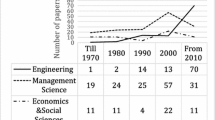Abstract
This paper looks at connections between the multi-criteria techniques of goal programming, compromise programming, and the reference point method. The utility function structure of each method is examined and interpretation of the techniques in terms of pareto efficiency and the equilibrated nature of the solution is given. Means of ensuring pareto efficiency whilst maintaining as much as possible the equilibrated character are given for a certain class of model. Methods for ensuring conceptual correctness and computational accuracy by reducing reference point models to equivalent goal programmes are given. The findings are illustrated by means of an example.
Similar content being viewed by others
Author information
Authors and Affiliations
Rights and permissions
About this article
Cite this article
Romero, C., Tamiz, M. & Jones, D. Goal programming, compromise programming and reference point method formulations: linkages and utility interpretations. J Oper Res Soc 49, 986–991 (1998). https://doi.org/10.1057/palgrave.jors.2600611
Received:
Accepted:
Published:
Issue Date:
DOI: https://doi.org/10.1057/palgrave.jors.2600611




